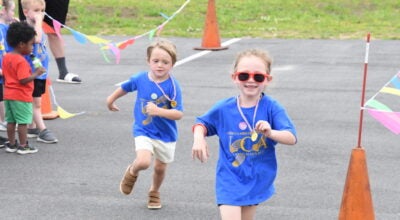Students find rhythm during Black History program
Published 4:25 pm Monday, February 3, 2014

John Scalici (left) leads Clanton Intermediate School students and principal David Seale in playing rhythms on djembe drums Monday during the school’s 13th annual Black History Program.
The auditorium at Clanton Intermediate School pulsed with rhythm from drumbeats Monday during the school’s 13th annual Black History Program.
Program speaker John Scalici used his authentic djembe drum from Guinea, West Africa, to convey his message of “Unity Through Rhythm” to students.
Scalici said his goal was to inspire, motivate and empower students to reach their full potential through the universal language of rhythm.
“In villages in West Africa, before there was a drum, people would make music by singing and clapping and stepping,” Scalici said. “Every event that happens in the life of a village is commemorated in a rhythm. The djembe is part of the fabric of village and village life.”
Scalici led students through interactive percussion exercises involving clapping and taught them how to produce different sounds on a djembe, a handmade drum that originated in West Africa and is constructed from the wood of a single tree and covered with goatskin.
Scalici said before the djembe became a drum, villagers originally used it as a mixing bowl for grinding millet, a cereal plant employed in food production.
Audible rhythms helped coordinate the motions of multiple villagers grinding the millet into powder, and eventually, the rhythms led to people using the bowls as drums.
“Every drum from around the world has its own set of syllables that are spoken while you play the rhythm,” Scalici said. “The djembe makes only three sounds.”
After Scalici demonstrated how to make the three sounds – bass, tone and slap – he invited students to come onstage and play rhythms on plastic djembes modeled after the authentic djembes like his from West Africa.
Then, Scalici invited CIS teachers to play the drums with him.
“I love West African music and West African culture,” Scalici said. “Every music that you enjoy and all of the instruments used in that music that you enjoy have roots in Africa.”
Scalici is a teaching artist, drum circle facilitator and musician.
He studied djembe music with Grand Master djembe players Mamady Keita and Fomadou Konate.
Through his company, Get Rhythm!, Scalici offers specialized programs for elementary, middle and high schools; colleges; corporate events; music and arts festivals; and more events across the United States and in Japan.
He is the recipient of the 2005 Fellowship Grant from the Alabama State Council on the Arts, the 2008 Pauline Ireland Award granted to individual artists and the 2010 Making a Difference award from the Alabama Alliance for Arts Education.






